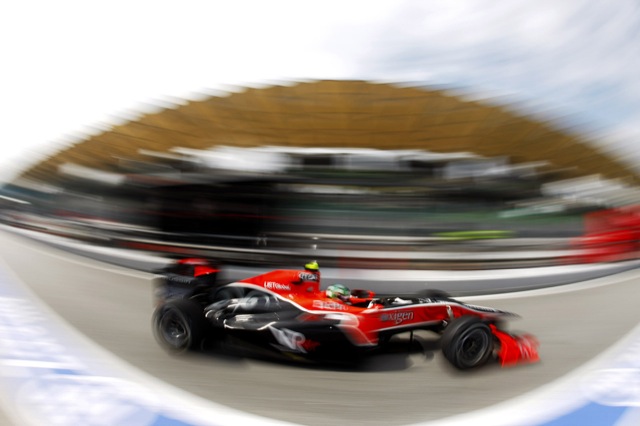The first completely new team for 2010 to launch came from the Virgin Racing camp, and although the actual event itself was a bit of a disaster, the car itself is fairly impressive in both the way it was born and the way it has been running so far in pre-season testing. The team has possibly the best funding of all the rookies, being backed by Richard Branson’s company after the entrepreneur switched his allegiance from Brawn in 2009 to the new project originally founded from Manor Motorsport and Nick Wirth.
Wanting to standout from their rivals, Virgin announced their car would be launched exclusively online to an audience of anticipated Internet users. Unfortunately, the show didn’t go without a hitch, or rather, it just didn’t happen. However, the car was eventually seen and has been billed as having been completely designed using Computational Fluid Dynamics. In a crude way of explaining, the car has been designed solely by computers. The VR-01 has not seen a wind tunnel, nor has it been penned out on a giant piece of pale blue paper.
Designing a car based solely on CFD is quite a risk, and although teams do obviously utilise computers in the design and development of their cars, Virgin are the first to go down this route 100%, ignoring the craft of pen and paper that has guided so many other designers to producing world championship winning machines. How this will translate to the race tracks is obviously yet to be fully seen, but without doubt, designer Nick Wirth is breaking new ground with the VR-01.
The car itself is certainly quite striking, painted in a red and black colour scheme with contrasting tattoo-like patterns flowing over the bodywork. Virgin have taken up some advertising space on the front and rear wings, sidepods and monocoque bridge. Elsewhere on the car other sponsor’s logos can be seen, which is encouraging for such a new team. It would seem as though they have even managed to retain financial services company FxPro in the sport by taking on their sponsorship after BMW pulled the plug last year.
The VR-01 has possibly the smallest sidepods on the grid thus far, and also the most pointed nose. The front view is impressive in not really looking like any other car that has so far been launched, although a Newey-dip is clear to see. The front nose has quite a pronounced curve to it as the line moves backwards towards the cockpit and all things said and done, it looks to be the prettiest so far.
Testing hasn’t gone quite as well as the team would have liked though, and despite passing all the crash tests, Timo Glock lost his front wing while charging around Jerez earlier in the month. Front wing failures are quite serious in Formula One, and many drivers have suffered an impact because, once fallen from its mounts, the wing can lodge itself under the front wheels, raising the car from the ground and removing any effect of steering and braking. Glock thankfully suffered no impact and cruised back to the pitlane, but the team were forced to halt their test due to a lack of spare parts and the need to understand why the part failed. The team stated they would be modifying the mounts before sending a driver out in the car again.
Virgin’s car designation system refers to the initials of the team name, Virgin Racing, and an incremental numbering system that for 2010, starts at the beginning. Hence, VR-01.
























Add comment